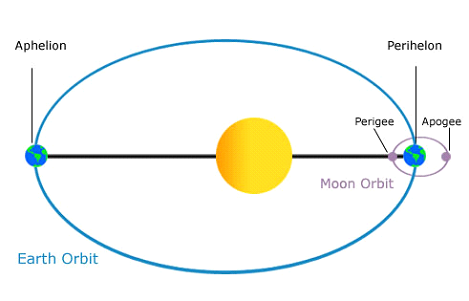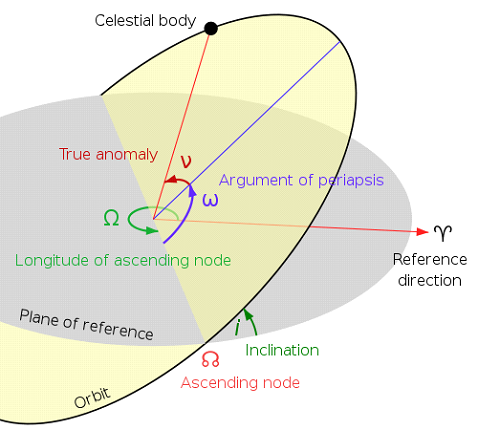Application of conic sections in astronomy. Orbits. Orbital elements
In astronomy conic sections are used to describe the orbits of celestial bodies.
Definition: An orbit of a celestial body is the trajectory the body describes while moving around another body under the force of gravity. (Fig. 4).
All bodies that are bound by gravitation in a planetary system (planets, dwarf planets, comets, asteroids, minor planets, etc.) have elliptical orbits and in one focus (the same for all bodies) is the central star. Similarly, the satellites (natural or artificial) have elliptical orbits around their planet.
The point from the orbit, where a satellite is closer to the Earth is called perigee, and the point, where it is furthest away is called apogee. If the motion is of a body around the Sun, these points are called perihelion and aphelion ; for an orbit around another star the terms are periastron and apastron, respectively (pericentre and apocentre are also used in the general case).
The planetary orbits in our solar system are ellipses with small eccentricities (i.e. they are close to circular). The most eccentric is the orbit of Mercury (е = 0.206), and less eccentric is that of Venus (е = 0.007). The comets, on the other hand, have very eccentric orbits (Fig. 5)

Fig. 4 Earth’s orbit around the Sun and the Moon’s orbit around the Earth. Credit: NOAA (https://www.nasa.gov/audience/forstudents/5-8/features/nasa-knows/what-is-orbit-58.html)

Fig. 5 Comparison between the orbits of the outer planets and the orbits of some comets. Credit: Tony Farnham
Orbital elements:
For each orbit, there is a particular set of parameters, which define its shape, dimensions, orientation in respect to a fixed plane, etc., collectively called orbital elements. When studying the motions of the bodies in the Solar system, the fixed plane of reference is the plane of the Earth’s orbit, called the ecliptic (coloured in blue on fig. 6).
For an elliptic orbit, the basic elements are:
- semi-major axis (denoted by a) – this is half of the majour axis of the ellipse, which passes through the centre and both foci (Fig. 2); according to Kepler’s third law, it is the length of the semi-major axis that determines the orbital period (the time it takes the body to do one full revolution on its orbit) of a celestial body. Its size also determines the distance from the Sun of the bodies in the Solar system (Fig. 7).
- eccentricity of the orbit (denoted by e), which together with the semi major axis determine the
shape and si ze of the orbit.
- inclination of the orbit – this is the angle between the plane of reference (the ecliptic for the Solar system) and the plane of the orbit.
Most of the Solar system planets have small inclination of their orbits (For Earth it is zero) – between 0.8 degrees (Uranus) and 7 degrees (Mercury) - Fig.8. Quite larger are the inclinations of the majority of dwarf planets and comets (e.g. Pluto’s orbit has inclination of 17 deg, and Eris has inclination of 43 deg).
Besides the above three elements, there are three more, which help to determine the spatial position of the orbit in reference to the ecliptic, the orientation of the orbit in its own plane and the moment in which the body passes through the perihelion. Thus, if we know all the elements of the orbit, we can precisely determine the position of a celestial body in any chosen time. Or, if we have long-term, precise observations of a celestial body, we can obtain the elements of its orbit.
Fig. 5 Comparison between the orbits of the outer planets and the orbits of some comets. Credit: Tony Farnham
Fig 4 Earth’s orbit around the Sun and the Moon’s orbit around the Earth. Credit: NOAA (https://www.nasa.gov/audience/forstudents/5-8/features/nasa-knows/what-is-orbit-58.html)

Fig. 7 Map of the Solar system.
Elementy eliptickej obežnej dráhy
V prípade eliptickej obežnej dráhy jej hlavnými elementmi sú:
■ veľká polos (a) – polovica veľkej osi prechádzajúca stredom a dvoma ohniskami elipsy (Obr. 2); podľa tretieho Keplerovho zákona veľká polos jednoznačne určuje obežnú dobu (čas potrebný, kým nebeský objekt vykoná jeden obeh okolo materského telesa). Veľkosť veľkej polosi určuje aj ako ďaleko sú planéty a ďalšie telesá od Slnečnej sústavy. Schematické usporiadanie je znázornené na Obr. 7,
■ excentricita orbity (e), ktorá spolu s veľkou polosou určuje rozmery a tvar obežnej dráhy (orbity),
■ sklon obežnej dráhy (i) je uhol medzi orbitálnou rovinou a ekliptikou (Obrázok 6). Väčšina planét zo Slnečnej sústavy má veľmi malý sklon (pre Zem je to samozrejme nula) – medzi 0,8 stupňov (Urán) a 7 stupňov (Merkúr). Ilustrácia je znázornená na Obr. 8. Oveľa väčšie sú sklony väčšiny trpasličích planét a komét (napríklad obežná dráha Pluta má sklon 17 stupňov a sklon Erida je 43 stupňov).


Fig. 8 Inclinations of orbits in the Solar system


